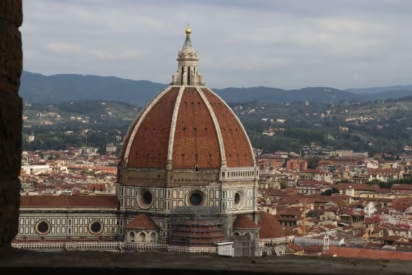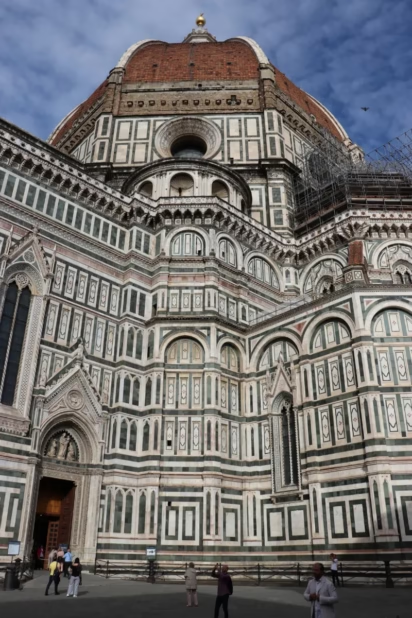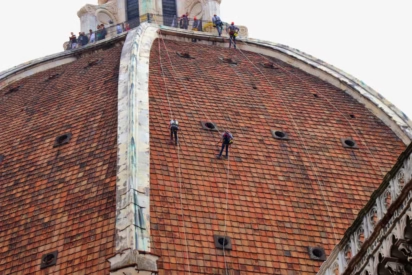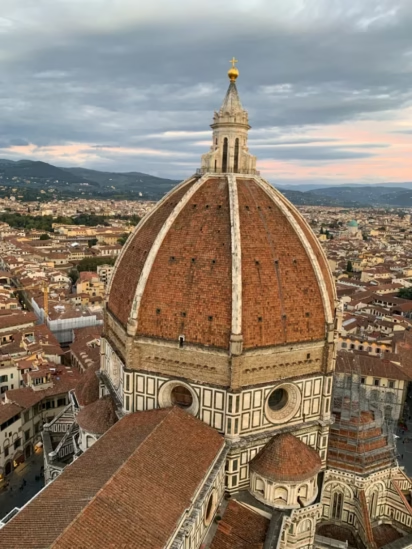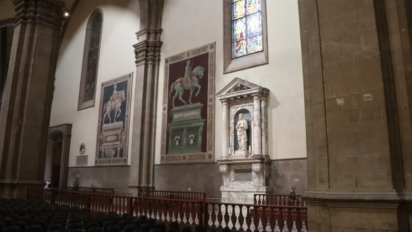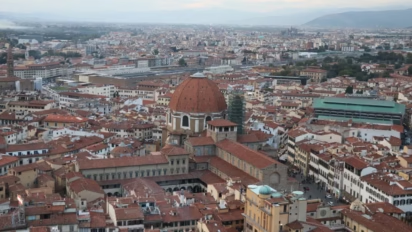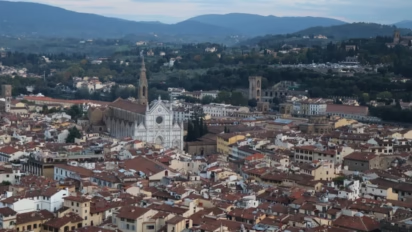Climbing the cupola (dome) Brunelleschi designed for the cathedral of Florence is for many visitors the highlight of visiting the Duomo complex in Firenze.

Brunelleschi’s dome over the crossing of the Duomo in Florence is an architectural and engineering masterpiece of the early 15th century. For over four centuries, it was the largest dome in the world. Visitors use staircases between the double domes to reach the viewing platform at the base of the lantern at the top of the cupola for panoramic views of the cathedral, Giotto’s campanile, Florence, and the lovely countryside of Tuscany. Climbing the cupola requires time-slot reservation tickets and is included in many guided tours of Florence or the cathedral complex.
→ From March 2025, tickets for the dome climb are linked to the buyer’s full name to prevent resellers from driving up prices. Time slots sell out even in the low season.
Construction of Florence Cathedral
When Arnolfo di Cambio designed the new cathedral for Florence at the end of the 13th century, he envisaged a dome to cover the crossing. Exactly how this dome would be built was not clear.
As the building of the cathedral dragged on, and designs were altered to build the nave as well as the eastern end far larger than originally planned, the question of the dome’s construction remained not only unsolved but grew in complexity.
By 1380, the nave was completed and despite the difficulty of the dome still unsolved, construction of the walls of the drum continued to add to further future complexities.
The Problem of the Dome for the Cathedral in Florence
The problems with the construction of the dome were multiple and complex but boiled down to a few basic issues: it would have to be the biggest freestanding dome ever constructed, flying buttresses were not allowed in Florence, and inevitably the question of financing.
Financing on its own hid a wealth of further issues, including Tuscany not having enough trees to support the scaffolding needed, never mind paying for the timber. The half-round apsis to the southern end of the church completed in 1418 used 32 tree trunks cut into 280 m of planks and 135 beams. It was calculated that the construction of the cupola would require 20 times more.
Such grand architectural projects were of national importance in an Italy where small city-states were in eternal competition and frequent wars. Giotto gave Florence the most beautiful bell tower in all of Italy but a cathedral with a permanently roofless crossing was awkward.
While a decorative church facade could wait, or even temporarily be faked, and Florence had lots of experience with that including San Lorenzo, which is still facade-less 500 years later, a church without a roof had the potential to quickly turn into a national embarrassment.
Competition to Build the Cupola of the Duomo in Florence
In 1418, one of Florence’s famous competitions for art and architectural work was launched to find a solution to the problem of building a dome for the cathedral. Various artists presented plans to build the cupola — many, including the winners, had no specific architectural training.
Filippo Brunelleschi (1377-1446), a trained goldsmith, won the competition in 1420 but to his intense irritation, Lorenzo Ghiberti was awarded co-responsibility. (A similar joint award to the two to produce the new bronze doors for the baptistry in 1401 led to Brunelleschi giving up fine arts for good.)
Brunelleschi played his cards close to his chest and rarely revealed far in advance how work should progress. Unlike Da Vinci, he left no drawings or notes, not even in code.
During the competition, Brunelleschi refused to explain exactly how or why his design would work but his boast that his plans could be realized without expensive ground-based scaffolding played a major role in winning the contract.
He famously challenged the jury and competitors to balance an egg on a bare table. When all failed, Brunelleschi smashed the egg down and the broken egg stood. When others complained that if they knew that could be done, they could make the egg stand too, Brunelleschi replied, exactly, if I tell you how to build the dome, you could do it too.
Brunelleschi vs Ghiberti
Brunelleschi had reason to be paranoid in pre-copyright times. He never received the 200 gold florins prize money for winning the competition. Furthermore, despite doing all the work, he received the same pay as Ghiberti except for the last few years of the project. History remembers Ghiberti for the doors of the baptistry and Brunelleschi for the cupola. However, that honor was of little immediate benefit to either.
At some critical point in the construction period, Brunelleschi became ill (or quite likely feigned illness). Once it became clear Ghiberti had no clue how to proceed, Brunelleschi made a complete recovery. Although Ghiberti continued to receive his full pay, it was clear that the credit belonged to Brunelleschi. In revenge, he had Brunelleschi briefly jailed in 1434 on rather spurious charges of being behind on union dues.
Construction of the Cupola of the Duomo in Florence

How the dome is constructed is easiest explained by observing the models and notes in the museum. The basic solution was two domes of interconnected ogival shells. The inner dome is from brick, which is lighter than stone, laid in a herringbone pattern so the dome became largely self-supporting. Special support rings of wood and concrete surround the dome at specific intervals to prevent it from collapsing.
The outer dome with its eight sandstone buttresses that join at the lantern is covered with tiles for lightness. The tiles are mostly decorative but the buttresses were essential for the stability of the entire structure.
Brunelleschi was a model employer for the time and concerned himself with every aspect of the project from the clay used for the bricks to transportation and safety on the building site. He designed special pulleys to hoist the bricks up — these machines were later sketched by a young Leonardo Da Vinci, otherwise would have been lost to history. He also used scaffolding that moved up with the growing dome and thus not required the vast space below the dome to be supported by enormous ground-based scaffolding.
Brunelleschi built for eternity and knew repairs and maintenance would be necessary in the future. He thus left the holes in the dome for the support poles to prevent some idiot from cutting at the wrong place and bringing the whole thing down. These holes can still clearly be seen in the dome painting even from the floor of the church and were used several times in the past during restoration work.
Completion of the Cupola of Florence Cathedral
The basic dome was completed in 1434 and the church was inaugurated in 1436 in the presence of the pope. Although Brunelleschi designed the lantern, it was only built after his death in 1446 and completed in 1461 with work taking almost as long as the entire dome. The gilt copper sphere and cross were only added two decades later. The original was destroyed by lightning around 1600.
The outside ring where the dome meets the walls of the drum is undecorated. Only the one side to the east has a balcony by Baccio d’Agnolo added in 1507. Michelangelo described it as looking like a cage for crickets, so the other seven sides remained bare.
It is often debated whether Brunelleschi’s cupola marked the end of the Gothic in Florence or the beginning of the Renaissance. Or a bit of both. Many see the nearby Brunelleschi-designed San Lorenzo church (with the smaller dome, unfinished facade, art-filled interior, the Medici Chapels, and Michelangelo-designed Laurentian Medici Library) as the true start of Renaissance architecture in Florence.
Measurements of the Cupola of the Duomo in Florence
Brunelleschi’s dome was an architectural and engineering masterwork. On completion, the dome of the Duomo in Florence superseded the 43.4-m dome of the Pantheon in Rome as the largest in the world. Although it remains the largest brick-and-mortar dome ever built, in 1871 the Royal Albert Hall in London with a diameter of 66.85 replaced the Duomo as the world’s largest freestanding dome. (The current record is the Singapore National Stadium (2013) with a diameter of 310 m — Wikipedia List.)
Some basic measurements of the dome of the Cathedral of Florence include:
- Diameter of the dome internal: 45.52 m (147 ft)
- Diameter of the dome external: 54.8 m (180 ft)
- Internal height: 90 m (300 ft)
- External height: 114.5 m (376 ft including the 21-m (69-ft) lantern)
- Height of the drum to the base of the dome: 52 m (170 ft)
- Steps to the viewing platform: 463
Around 4 million bricks were used in the construction of the dome. The total structure weighs around 37,000 tons — the similarly sized but taller St Peter’s dome in Rome weighs only 14,000 tons due to thinner masonry.
Less flattering are the 1500 cracks that have been detected in the interior dome — some are visible from ground level. The first cracks already appeared during construction. On the whole, 1500 cracks after nearly six centuries are still more impressive than a pile of collapsed bricks.
Vasari’s Ceiling Painting of the Interior of the Dome

Brunelleschi would have liked the interior of his dome to shimmer with the sparkle of golden mosaics or paint but his wishes were never fulfilled or seriously contemplated on cost grounds. The interior of the dome was simply whitewashed until the late 16th century.
The famous art historian (or gossip) Giorgio Vasari (1511-1574) designed the Last Judgement fresco 1572-9 to cover the 3,600 square meters (38,750 sq ft) ceiling of the dome. Vasari intended a work more impressive than Michelangelo’s Sistine Chapel fresco but failed similarly to Michelangelo’s inability to improve on Brunelleschi’s dome. (At least Michelangelo had the good sense to announce well in advance that St Peter’s dome will be taller but not more beautiful than Brunelleschi’s cupola.)
By the time of his death, Vasari had painted only a very small part of the fresco (a few of the elders near the lantern). Most of his design was completed after his death by less talented painters led by Federico Zuccari, who often painted on dry rather than wet mortar. They even managed to get a few limbs wrong but given the beasts of hell, it is hard to determine if it was intentional or not.
Vasari’s painting has been criticized both for its design and the quality of the art. The painting makes the dome appears lower rather than letting it soar into the sky. Many thought a return to the whitewash would have been a better investment than the money spent on a very expensive restoration project at the end of the 20th century.
Cupola Painting

However, the painting is easy to enjoy. The main scene visible from the nave is the Last Judgement. At the opposite end is the three-faced devil stuffing humans into his three mouths. The main scenes in rings from the lantern down: the 24 Elders, Choirs of Angels, Christ, Mary and Saints, the Virtues, and finally the Capital Sins and Hell. The latter ring is particularly popular and best seen from the walkway at the top of the drum when visiting the cupola. The painting has an incredible number of bare buttocks — not only in hell — while full-frontal nudity is used more sparingly.
Some of the around 1500 cracks in the dome are visible from floor level. The first cracks already appeared during the construction of the cupola and it is now constantly monitored.
Climbing the Cupola of the Duomo in Florence
Climbing the dome to the external viewing platform at the bottom of the lantern is done via 463 steps. Time-slot reservation tickets are essential.
Tip: When entering the church with a dome climbing ticket, have a quick look at the three frescos on the northern aisle wall and take a wide sweep to see the rest of the church to confirm queuing more than ten minutes to gain entry is probably a waste of time better spent elsewhere in Florence. Guided tours give fast admission and may include visits to parts of the church cordoned off to non-paying visitors.
Climbing the dome is done in two basic phases: the first set of wide stairs leads up to the circular walkway at the top of the drum and the base of the dome. From here, enjoy the close-up view of the painting — hell is almost within touching distance. The door to the next flight of stairs is on the opposite end so enjoy a full half circle to see the painting better (and see it from the other side on the down journey when the other half of the ring is used). To take photos, step to the opposite side of the general flow of visitors as soon as reaching the ring — there are small sections where it is possible to remain stationary without holding up other visitors.
The second flights of stairs are between the two domes. Although not particularly claustrophobic, these stairs were never designed with the half-million visitors they receive annually. Visitors see the special design features close up and at times it is not possible to walk upright for small sections. It is not a difficult climb but for some with limited mobility, it may be a bit more challenging. Opportunities to pass or rest are limited.
Panoramic Views of Florence from the Cupola
The view of Florence from the platform at the top of the external dome at the base of the lantern is glorious. From here the whole city may be seen as well as how close the green countryside of Tuscany is to the city center. Visitors may appreciate the length of the long nave of the cathedral and the beauty of the slender campanile of Giotto. Only the lantern and top of the roof of the baptistry can be seen behind the western facade of the church.
Alternatives to climbing the cupola are to scale the campanile instead. The viewing platform here is only around 10 m lower than the base of the lantern of the dome and besides the view includes the cupola. A further option is a guided tour of the terrace at the external height of the lower nave roofs — these are reached via wide staircases.
Views of the entire cathedral complex with both the campanile and cupola visible are possible from many vantage points in Florence including the Palazzo Vecchio, Boboli Gardens, the Forte di Belvedere, or completely for free from the Piazzale Michelangelo (with a bronze copy of his David and statues from the Medici Chapel).
Tickets and Opening Hours of the Cupola
The cupola is open daily from around 8:30 to 19:00 but often Sundays only a few hours in the afternoons. Time-slot reservations are essential to climb the cupola. These are made when buying tickets at the official website, or when buying at the ticket shops at the Duomo (a risky option except in the low season). Neither the dome nor other Duomo sites are currently included in the Firenze Card.
From March 2025 identification is checked to make sure names and tickets match to prevent reselling.
Line up with time-slot reservations at the specific door at the northern side of the church near the apsis at most ten minutes before the stated time and a maximum of 5 minutes after Have a quick look at the church after entering to confirm that there is not that much to see to warrant spending hours waiting to enter even for free.
Guided tours may be an option to secure tickets at busy times and could offer combinations to see David, which is also a ticket headache at busy times.
→ See 2025: Florence New Opening Hours of Top Sights, Museums, and Churches for the latest information and current opening hours.
More on the Duomo in Florence
- Visit the Cathedral of Florence (Duomo di Firenze)
- Visit the Baptistry (Battistero)
- Climb Giotto’s Campanile
- Climbing the Brunelleschi Campanile
- Museo dell’Opera del Duomo (Museum of the Works of the Cathedral)
- Tickets and Opening Hours for Visiting the Duomo Sights in Florence
- Current Opening Hours for Top Sights in Florence
- Guided Tours of the Duomo Sights
- More Photos on Flickr
More Articles on Florence Sights
The high season in Florence is increasingly long: Easter, May, July, August, and the Christmas holidays are especially busy. November and January to mid-March are the only quiet months, except for the February school holiday week. Plan and book time-slot reservation tickets and tours when available in advance — the Accademia and the Uffizi are again sold out weeks in advance. Top sights are quieter directly at opening time or in the late afternoon.
→→ Opening hours for top sights in 2025 — most sights have long hours but advance time-slot reservations are always sensible.
- Tips on Buying Tickets for the Uffizi Museum
- Tips on Buying Skip-the-Line Tickets for the Accademia (Michelangelo’s David)
- See Michelangelo’s David in the Galleria dell’ Accademia
- Visit the Duomo sights: Cathedral (Duomo), Baptistery (Battistero), Bell Tower (Campanile), Dome (Cupola), Museum (Museo), and Tickets + Opening Hours
- Visit the Bargello Museum of Sculpture (Donatello’s Davids)
- Visit San Marco Museum to see the frescoes and altarpieces painted by Fra Angelico.
- Visit Santa Maria Novella Church and Museum to see medieval and Renaissance Art.
- Visit Santa Croce for Giotto Frescoes and Michelangelo’s Grave
- San Lorenzo complex: Visit the Basilica for Renaissance Art, See the Laurentian Medici Library by Michelangelo, and Visit the Medici Chapels (Michelangelo Statues)
- Visit the Orsanmichele Church and Museum with sculptures.
- Save on Sightseeing in Florence with the Firenze Card (again available but not including transportation or the Duomo sights, or consider the Turbopass Florence City Pass that includes online timeslot reservations for both the Uffizi and Accademia.
- Travel to Pisa to see the Field of Miracles and the Leaning Tower of Pisa.
- Visit the magnificent Romanesque-Gothic cathedral in nearby Siena.
- Save on top Italian designer fashion at The Mall Factory Outlet Stores.
Florence Resources
- The official website of the Firenze Tourist Office is a bit cumbersome but has very useful information. Especially the pdf (alternative link) with the opening hours of all major sights. Unfortunately, it is only available for the current month but it is the second last line on opening hours — the final say is the guard at the door, NOT the ticket window!
- Get Your Guide offers tours of all major sights while Tiqets sells online tickets for many top sights in Florence.
- Book luggage storage online and explore Florence more easily on foot.
- Trainline is good for booking online train tickets in Italy and most of Europe.
